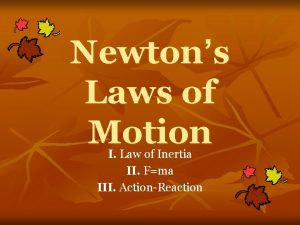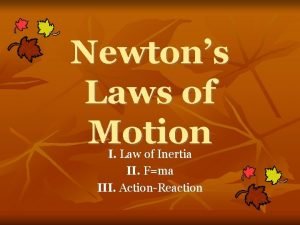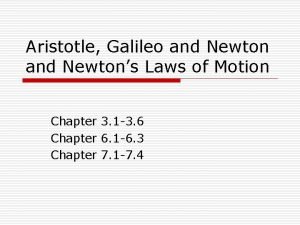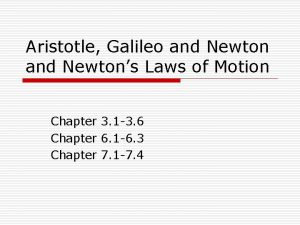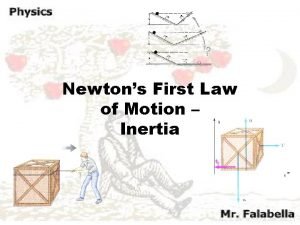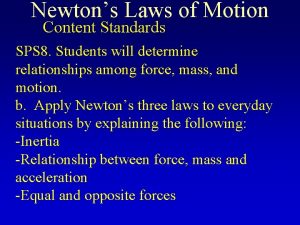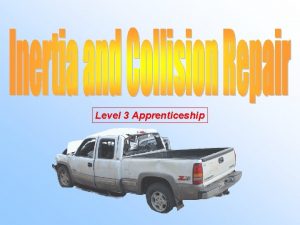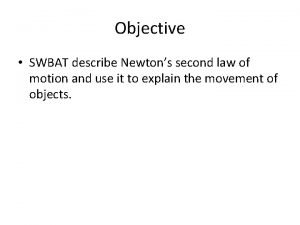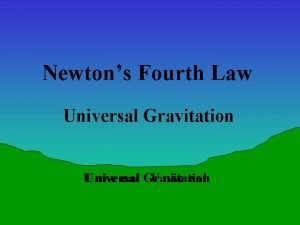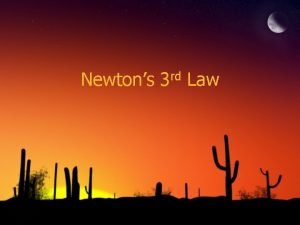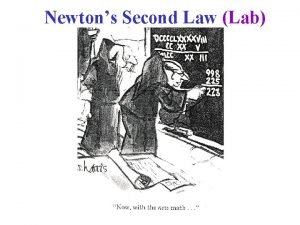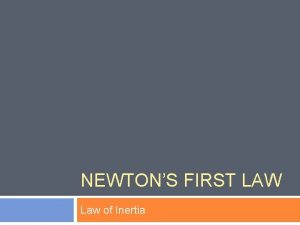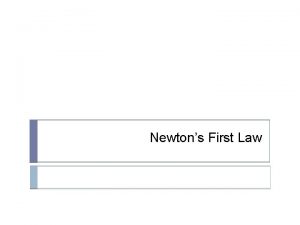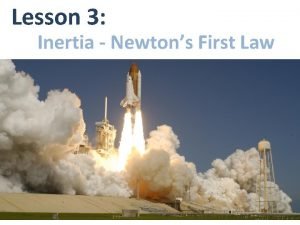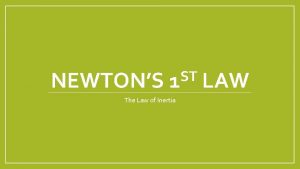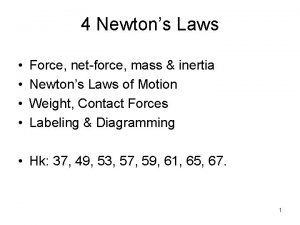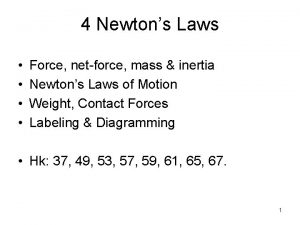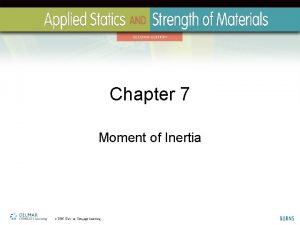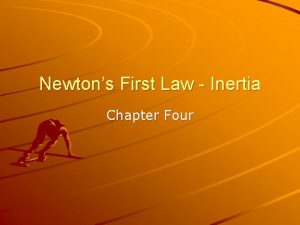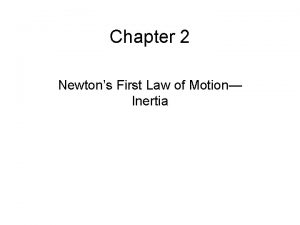CHAPTER 3 NEWTONS 1 ST LAW Inertia NEWTONS




















- Slides: 20

CHAPTER 3: NEWTON’S 1 ST LAW Inertia

NEWTON’S FIRST LAW If a ball was lying in the middle of an empty field and began moving, what would be your first thought? We do not believe that changes in motion occur without cause

ARISTOTLE Greek scientist studied motion and divided it into two types Natural Motion � It was natural for heavy objects to fall and for light things to rise (such as smoke) � Circular motion was natural for the heavens, thus stars and planets revolved Violent Motion � Imposed motion to objects (a cart pulled by a horse) � Objects in a resting place must have an external cause for movement

COPERNICUS Reasoned that the simplest way to interpret astronomical observations was to assume that Earth and the other planets move around the sun. Very controversial � Had to work on his ideas in secret to escape persecution � First copy of his work reached him on the day of his death

GALILEO Galileo-foremost scientist of the time arrested for support of Copernicus Had to do all his work without mechanical clocks � Used pulse, dripping of water droplets, etc � Einstein called him the father of modern physics Galileo demolished the notion that a force is necessary to keep an object moving.

FRICTION Friction is the name given to the force that acts between materials that touch as the move past each other. � Caused by the irregularities in the surfaces of objects � Even very smooth surfaces have microscopic irregularities that obstruct motion Galileo argued that only when friction is present is a force needed to keep an object moving.

FRICTION Galileo tested this theory by rolling balls along plane surfaces tilted at different angles. a. The ball rolling down the incline rolls up the opposite incline and reaches initial height. b. As the angle of the upward incline is reduced, the ball rolls a greater distance before reaching initial height c. If there is no friction, the ball will never stop rolling unless it hits something

FRICTION Aristotle had claimed that the nature of the ball would be to be at rest. Galileo claimed that a moving body tends to keep moving and that it is natural. Every material object resists change to its state of motion. Inertia is the property of a body to resist changes to its state of motion.

NEWTON’S LAW OF INERTIA By age 24, Isaac Newton had developed his famous laws of motion Newton’s first law, law of inertia, states “Every object continues in a state of rest, or of uniform speed in a straight line, unless acted on by a nonzero net force. ” Restate this in your own terms. What examples of this did you observe? Relate this to the equilibrium rule

OYB What is Newton’s First Law of Motion?

INERTIA What determines the amount of inertia? Ever heard the phrase, “The bigger they are, the harder they fall? ” The more mass an object has, the greater its inertia and the more force it takes to change its state of motion. � Mass is a measure of the inertia of an object. � Do not confuse mass and volume

MASS Mass is not the same as weight How do we normally determine the amount of matter in an object? Mass is more fundamental than weight. � Mass is the amount of material in an object: depends only on the number of and kind of atoms � Weight is the measure of the gravitational force acting on an object.

MASS VS. WEIGHT What is mass? � Quantity of matter in an object � A measure of the inertia or “laziness” that an object exhibits in response to any effort made to start, stop, or change its state of motion What is weight? � Force � They of gravity on an object are not the same, but are proportional in a given place. In the same location, twice the mass weighs twice as much.

OYB Does a 2 -kilogram bunch of bananas have twice as much inertia as a 1 kilogram loaf of bread? Twice as much mass? Twice as much volume? Twice as much weight, when weighed in the same location? (Write key word: then yes or no)

THE MOVING EARTH Copernicus introduced the idea of a moving earth in the 16 th century His theory would have to mean that the Earth has to move at a speed of 107, 000 km/hr to circle the sun in one year. OYB Convert this speed to km/sec Argument against: a bird at rest in a tree sees a fat worm on the earth below him. The bird drops down vertically and catches it. This can’t be possible if the Earth moves as suggested because the worm would have been swept away by the Earth for a distance of 30 km. This is proof that Earth must be at rest.

OBJECTS MOVE WITH EARTH Can you refute the previous argument? Invoke the idea of inertia � Objects in motion remain in motion if no unbalanced forces act upon them � What all is moving? Earth, tree, branch of tree, bird, worm, air between When the bird drops from the branch, its initial sideways motion remains 30 km/s and is unaffected by the motion of the total environment The speed of Earth is relative to the sun, not of the bird to the worm

OYB How fast are you moving relative to Earth when you are standing still? How fast are you moving relative to the sun?

OYB If you’re in a smooth riding bus that is going at 40 km/hr and you flip a coin vertically, how fast does the coin move horizontally while in midair?

OBJECTS MOVE WITH VEHICLES Why was it so hard for people then to accept ideas like this? � Didn’t know about inertia � Not accustomed to moving in high speed vehicles Slow, bumpy rides in carriages do not lend themselves to experiments revealing inertia Flip a coin in a car or airplane, what happens? Aristotle didn’t recognize inertia because he didn’t realize that all moving things follow the same rules

INERTIA SAFETY In Taipei, there is a more than 3 million kg steel ball that helps stabilize the 101 story building against vibrations caused by earthquakes and strong winds. Why would this work?
 Inertia in life
Inertia in life Examples of newtons first law
Examples of newtons first law Five laws
Five laws Law of inertia
Law of inertia Newtons laws
Newtons laws Galileo law of motion
Galileo law of motion Law of inertia
Law of inertia Aristotle law of inertia
Aristotle law of inertia Newton's laws
Newton's laws Define law of inertia
Define law of inertia Newton's first law and second law and third law
Newton's first law and second law and third law Si unit of newton's first law
Si unit of newton's first law Boyles law
Boyles law Charles law constant
Charles law constant Newtons 3 rd law of motion
Newtons 3 rd law of motion Newtons second law in soccer
Newtons second law in soccer Describe newtons second law
Describe newtons second law Newton's fourth law example
Newton's fourth law example Newtons 3 rd law of motion
Newtons 3 rd law of motion Newtons 3 rd law of motion
Newtons 3 rd law of motion Newtons 3 rd law
Newtons 3 rd law


